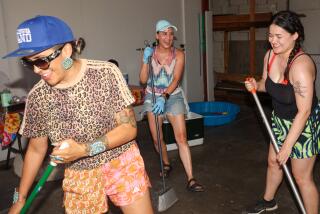Chumash Revive Culture After Years on the Shelf
- Share via
Connie Diaz remembers the day her daughter came home from school, angry after a lesson about the Chumash Indians.
“They were teaching her things like, ‘When the Chumash were here, they liked to fish and eat venison,’ ” said Diaz, a Ventura County resident who is part Chumash.
“My daughter said: ‘Mom, I just had to let them know that we’re still here. They always talk about us as if we don’t exist anymore.’ ”
That was a few years ago, in a time when the Chumash were treated by archeologists as practically extinct, like the California condors that used to soar over their lands.
But today a sort of Chumash renaissance is taking place. The descendants of the tribe--there are no more pure-blooded Chumash--have become more attuned to their origins, and the interest of outsiders has also been piqued.
In some respects, the Chumash have practically vanished. Scarcely 200 years ago, as many as 20,000 Chumash inhabited the coast between Malibu and San Luis Obispo. Today, anthropologists say, there is not one pure-blooded Chumash left.
But there are an estimated 4,000 people of Chumash descent living in the region, most of them in Ventura and Santa Barbara counties.
Through intermarriage, mostly with people of Mexican descent, the Chumash have been assimilated into the American “melting pot,” according to John Johnson, curator of anthropology at the Santa Barbara Museum of Natural History.
As they have struggled to discover their own origins and make their presence felt in recent years, they have had to overcome a number of obstacles, some stemming from ancient times.
Historians say the Chumash never had the strong tribal organization and geographic isolation that helped larger Indian nations, like the Navajo, maintain their identity. The Chumash were linked primarily by a common language, and by 1923 only a dozen people spoke it. The last person to speak the Chumash language died in 1962.
For many Chumash today, pressures of daily life also get in the way of cultural fulfillment, social workers say.
Bruce Stenslie, deputy director of the Candelaria American Indian Council in Oxnard, said unemployment, homelessness and broken families tend to occur more frequently among the Chumash and other Native Americans than the population at large.
Despite the obstacles, many Chumash have taken to learning more about their heritage and culture, and some are sharing it with the public in folklore, songs, dances and art.
Ernestine McGovran, a Santa Paula nurse whose mother was the last Chumash to speak the language, tells Chumash stories and demonstrates basketry arts. Vincent Tumamait, who is three-quarters Chumash, talks about his ancestors and sings Chumash songs to school groups. Tony Romero, who lives at the Chumash Reservation in Santa Barbara County, and other Chumash descendants demonstrate dances with a group called the Dolphin Dancers.
They and other Chumash take part in well-attended programs sponsored by the National Park Service, the Forest Service, several municipal park departments, the Santa Barbara Museum of Natural History and the Ventura County Museum of History and Art. Almost every school district in Ventura and Santa Barbara counties includes studies of the Chumash as part of the curriculum.
Virtually everyone involved in the revival seems anxious not to resurrect old issues that have divided the Chumash, such as who--if anyone--should speak for the tribe; who should get monitoring jobs at construction sites where Chumash artifacts are found; and the most basic question of all:
Who is a Chumash?
Chumash ancestry can be determined through mission records or “judgment rolls”--lists compiled by the government in the 1920s and the 1960s to determine who was entitled to federal payments as compensation for broken treaties.
Connie Diaz has a blue suitcase crammed with such records. Her Chumash connection is the baptismal record for her grandmother, Maria Rafaela Leiba, whose mother is listed as Maria Neofita. Neofita, the Spanish word for “newly baptized,” was the name commonly given to Chumash converts.
Diaz said her mother often talked about her Indian heritage, but Vincent Tumamait said his father never discussed the subject and refused to speak the language.
“One of my sisters asked my father to teach her some of the language,” Tumamait said. “His answer was: ‘Who would you talk to?’ ”
At Shell Oil Co. in Ventura, where Tumamait worked for 30 years, he would list himself on company records as an American Indian or a Mission Indian--a catch-all term for various Southern California tribes--but not as a Chumash.
“I didn’t hear that word till a few years back,” Tumamait said, referring to the day in 1984 when Ward approached him about doing some cultural programs through the Ventura Parks and Recreation Department.
That was the start of a self-discovery that is still going on, he said.
“It started to build up in me just what our culture was,” he said. “I’m still learning it. . . . The Indian people I meet teach me. I’m a learner.”
More to Read
Sign up for Essential California
The most important California stories and recommendations in your inbox every morning.
You may occasionally receive promotional content from the Los Angeles Times.










